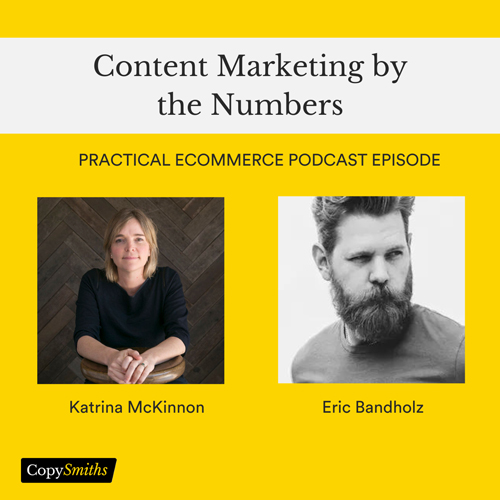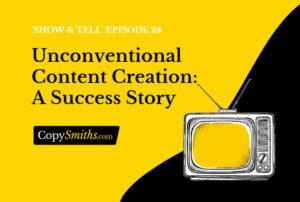Home » Podcasts » Content Marketing by the Numbers

Content Marketing by the Numbers
In this interview, Katrina McKinnon shares how she and her team produce hundreds of articles that ranked in Google’s search results.
Katrina McKinnon and Eric Bandholz talk about the effective formula to make blog posts rank in Google search results for eCommerce clients.
“You need between 1,000 to 1,500 words for a blog article. Definitely not 600. Avoid 800, unless you’re literally just answering a short question. You need a heading that includes a keyword. You need three to four subheadings, H2s. And then within those H2s, you need three to four H3s. H3s are very important.” – Katrina McKinnon

Below is the transcript of Katrina McKinnon and Eric Bandholz’s conversation, edited for length and clarity.
Is Search Engine Optimization Dead?
SEO is far from dead. What we do is simple. We answer people’s questions. Say someone asks, “What is a martingale collar?” We’ll write an article that answers that question. We do all the basics. We include a checklist so people can easily read the answer.
We’ll insert a quotation or some social proof that says, “Well, this person really enjoyed this martingale collar because it helped them with their dog.” What’s the average price of it? What’s the length? What are the dimensions of a martingale collar? How do you use it? And so we provide good content.
How Long Do These Articles Need to Be? What Should They Include?
There are certain tools that we use to get the exact numbers. You need between 1,000 and 1,500 words for a blog article. Definitely not 600. Avoid 800, unless you’re literally just answering a short question like how to cook rice. But if it’s, “What is a martingale collar and how to fit it,” then maybe 1,200, 1,400 words. You need a heading that includes a keyword.
You need three to four subheadings, H2s. And then within those H2s, you need three to four H3s. H3s are very important.
And with the H3s, try to answer a question that someone is asking on Google and include a keyword. Keep your paragraphs to one to two sentences. Three sentences at the absolute most. If you’ve got more than three sentences and paragraphs, chop off one, the last sentence, and put another paragraph.
Include one ordered list and one unordered list. Include one quotation or social proof, such as, “Sally said that the martingale collar was the best she’d ever had.” Include one of those per 1,000 words. So if you’ve got an article of 2,000 words, put two of them in. And link to an authoritative source.
Wikipedia, HuffPost, Business Insider — none of those are authority sources. You have to go to page four of Google to find an authoritative source. Those big publications like HuffPost are all just automated bots that churn out generic stuff.
Who Decides What to Write About, You or the Client?
Some of our clients know SEO and have a vision of what they want. Others rely on us to generate ideas and keywords. But we’re all making it up as we go along because the algorithms are so complicated.
CopySmiths
I'm Katrina McKinnon, founder of CopySmiths and Small Revolution. In my 20 years of experience, I have helped online businesses create high-performing content specifically on an eCommerce store's blog. Find me on LinkedIn and Twitter.

CopySmiths offers the best blog writing services for online stores.
If you'd like us to write blog articles for you, click here.
Most Recent
- 3 Bold Questions You Should Ask When Hiring A Content Writer

- 5 Practical Reasons You Should Use a Blog Post Template

- 4 Amazing Benefits of Using a Title Generator for New eCommerce Blogs

- 10 Awesome Bio Examples Your Online Store Blog Should Emulate

- 8 Basic Steps to Successful Content Development Every Time

Podcasts
Got a question?
Ask our friendly team about our article writing services.
Subscribe to CopyZine
Monthly, hand-picked stories of the best in eCommerce Content.




